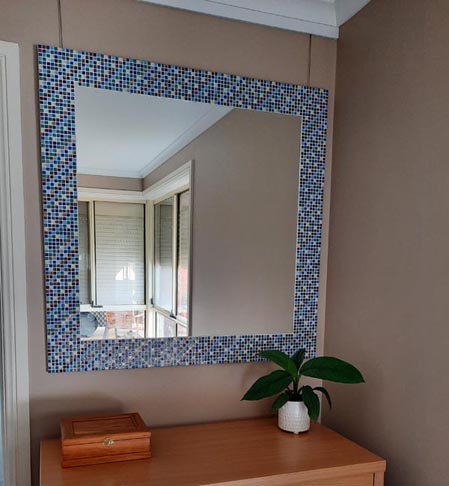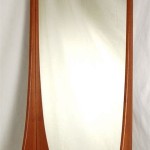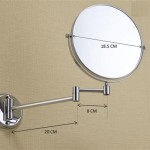Hanging Mirrors on Plasterboard
Plasterboard, also known as drywall or gypsum board, is a common wall material in modern homes. While aesthetically pleasing and easy to work with, its lightweight nature presents challenges when hanging heavy objects like mirrors. This article outlines safe and effective strategies for securely mounting mirrors of varying sizes and weights onto plasterboard walls.
Key Considerations for Hanging Mirrors on Plasterboard
Several factors influence the best approach for hanging a mirror on plasterboard. These include the weight and size of the mirror, the location on the wall, and the type of wall framing behind the plasterboard.
Determining Wall Framing
Locating the wall studs is crucial for providing the most secure support, especially for heavier mirrors. Electronic stud finders are readily available and provide a quick and accurate method for locating studs. Alternatively, gently tapping the wall and listening for a change in sound from hollow to solid can help pinpoint stud locations. Marking these locations aids in planning mirror placement.
Hanging Lightweight Mirrors
For smaller, lighter mirrors, specialized plasterboard fixings often suffice. These include:
- Hardwall Hangers: These feature small pins that are driven directly into the plasterboard. While easy to use, their weight capacity is limited. They are best suited for very lightweight mirrors in non-high-traffic areas.
- Self-Drilling Drywall Anchors: These anchors create their own pilot holes and are suitable for slightly heavier mirrors. The anchor expands behind the plasterboard, providing a more secure grip than hardwall hangers.
- Plastic Toggle Bolts: For medium-weight mirrors, toggle bolts offer greater holding power. A hole slightly larger than the toggle is drilled, and the bolt is inserted with the toggle folded. Once through the wall, the toggle expands, distributing the weight behind the plasterboard.
Hanging Heavy Mirrors
Heavier mirrors require a more robust mounting solution anchored directly to the wall studs. This ensures sufficient support and prevents the mirror from pulling away from the wall.
- Screws Directly into Studs: This is the most secure method for hanging heavy mirrors. Pilot holes are drilled into the studs, and screws are used to secure the mirror directly to the framing. This method provides the highest weight capacity.
- Heavy-Duty Wall Anchors: For situations where mounting directly to a stud is not feasible, heavy-duty wall anchors such as molly bolts or threaded drywall anchors can be used. These anchors provide significant holding power and can support heavier mirrors.
Choosing the Correct Fixings
Selecting appropriate fixings is critical for safety and stability. Always check the weight capacity of the chosen fixing and ensure it exceeds the weight of the mirror. Overestimating the weight of the mirror is recommended as a safety precaution. Consider the material of the wall framing as well, as some fixings are better suited for wooden studs while others work well with metal studs.
Safety Precautions
Safety should always be a priority when hanging mirrors, especially heavier ones. Following these guidelines will help ensure a safe installation.
- Use Appropriate Safety Gear: Wear safety glasses to protect eyes from dust and debris. Gloves can provide a better grip and protect hands.
- Enlist Assistance: Larger or heavier mirrors are best handled with a helper to avoid accidents and ensure proper alignment during installation.
- Consider the Mirror’s Location: Avoid hanging heavy mirrors above beds or seating areas to minimize risks in case of accidental detachment. Securely anchoring the mirror is especially critical in areas prone to vibrations or movement.
Preparing the Wall
Prior to hanging the mirror, ensure the wall surface is clean and free of dust or debris. This promotes better adhesion for certain fixings. If necessary, lightly sand any imperfections to create a smooth surface for the mirror backing.
Marking and Measuring
Accurate measuring and marking are crucial for proper mirror placement. Use a level to ensure the mirror hangs straight. Measure the distance between the hanging points on the back of the mirror and transfer these measurements to the wall, marking the location of each fixing point. Double-checking these measurements avoids misalignment.
Attaching the Mirror
Once the fixings are installed and the wall is prepared, carefully hang the mirror on the chosen hardware. If using wire or D-rings, ensure they are securely attached to the mirror frame and are rated to support the mirror's weight. Gently lower the mirror onto the fixings, ensuring it sits securely in place. Once the mirror is hanging, check its stability and make any necessary adjustments. For larger mirrors, using shims can help achieve perfect leveling.

How To Hang A Very Heavy Picture Or Mirror The Best
How To Hang A 100 Pound Mirror On Drywall Quora

How To Hang A Heavy Picture On Plasterboard Wall

How To Hang A Mirror On Plasterboard Wall Soraya Interiors

Gripit How To Hang A Mirror Onto Plasterboard Wall

How To Hang A 31kg Mirror On Wall With Bunnings Work Community

Hang A Mirror On Plasterboard Wall Soraya Interiors

How To Hang A Large Or Heavy Mirror

Hanging A Mirror On Plasterboard Wall Howto

How To Hang A Very Heavy Picture Or Mirror The Best








